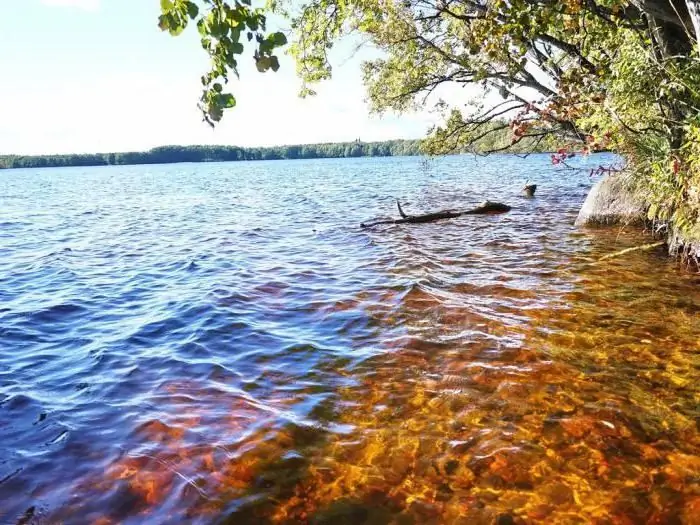- Author Harold Hamphrey [email protected].
- Public 2023-12-17 10:06.
- Last modified 2025-01-24 11:10.
Not far from the small village of Onufrievo, on one of the slopes of the Klinsko-Dmitrovskaya ridge, in a basin formed by high hills of glacial origin, Trostenskoye Lake is located, the third largest in the Moscow region. Despite the relatively large area (7.3 sq. km), its maximum depth hardly reaches 3-4 meters, but the bottom is very muddy, and the banks are swampy. The name of the reservoir was given by the locals because of the abundance of reed vegetation around the lake. This quiet clean place is located away from big and noisy roads and settlements.

History of origin, settlement and use
Lake Trostenskoe is currently a remnant of a very large body of water left after the last ice age, before it occupied the entire basin. Near it, human settlements appeared in the Stone Age; archaeologists have found more than one burial site of ancient people's settlements. Trade was carried out along the rivers flowing into the lake, and timber was rafted to Moscow. In the 14th century, Trostenskoye Lake became a battlefield between the Moscow principality andLithuanian. In the 16th century, this reservoir was taken over by the monasteries and remained the property of the church for a long time. During the Second World War, fierce battles took place in the vicinity of the lake. Under the Soviet Union (in 1966), a reserve was organized here, which was administered by

Military hunting society. Two fishing bases rented boats, from which visitors could fish, or enjoy the views that Trostenskoye Lake gives. But, unfortunately, the bases were liquidated in 2006.
Flora and fauna
As already mentioned, the lake is surrounded by dense thickets of reeds, but the woody vegetation is well developed. Although the species composition was severely damaged after massive cuttings in the past, the forest has almost completely lost valuable tree species. For 150-200 meters to the shore, the forest turns into reeds, sedges and reeds. Of the small vegetation, Lake Trostenskoye boasts rare species, some of which are included in the Red Book of the Moscow Region. The reservoir is also rich in ichthyofauna, it was it that attracted and still attracts fishermen from all over the region and not only. The populations of perch and roach are the most numerous, but fish live here

and bigger ones like pike, burbot, bream and ide. By the end of the 20th century, due to poaching, fish stocks were sharply reduced, the situation was complicated due to the closure of fishing bases and the weakening of state control. But oddly enough, Lake Trostenskoe is famous for its fish.
Fishing and recreation
Thanks to the good ecology and the rich composition of the ichthyofauna, Lake Trostenskoe, whose photos are picturesque, attracts many fishermen and just tourists. A number of rivers will flow into the reservoir, but, remarkably, a river also flows out of it, it is called Ozerna. The nearest settlement (the village of Onufrievo) is located 1000 meters to the southeast. Previously, fishing bases provided visitors with everything they needed, but now, if you decide to fish, you will have to take both a boat and a tent with you. This place is also great for a family vacation in nature. You can arrange housing with local residents, or you can relax as "savages" in tents by the fire.






